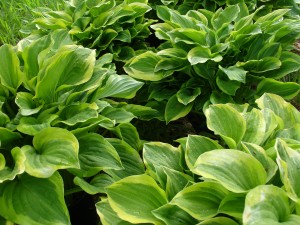 Gardening in the shade can be a challenge for gardeners of all experience levels. Luckily, plant breeders have given us a huge array of Hostas to work with!
Gardening in the shade can be a challenge for gardeners of all experience levels. Luckily, plant breeders have given us a huge array of Hostas to work with!
Hostas grow best in rich loam with plenty or organic matter, but will tolerate average garden soil. To get the best out of your hostas in our lean island soil, be sure to amend the bed at planting with compost or composted cow manure. Once established, be sure to give them sufficient water and a top-dressing of organic mulch each year.
The major insect pests of Hostas are slugs and snails. They emerge at night to feed, and hide during the day. The tell-tale sign of slug and snail damage is their slimy trails left on the underside of the leaves. Effective organic controls are available and effective. Pelleted products such as Sluggo do a good job of keeping these pests at bay, while not causing the environment any harm. If you still find a lot of damage, try Hostas with leathery leaves, like ‘Krossa Regal.’
Although they prefer dappled shade, morning sun is fine for all types of Hostas on Nantucket. There are even Hostas that will perform in full sun! Those with green or chartreuse leaves tend to tolerate sun better than variegated varieties. ‘Guacamole’ and ‘Sum and Substance’ are both good choices for sunny situations, just be sure to keep them very well watered.
The form and type of leaves that Hostas display is varied. There are miniature plants that could fit in the palm of a child’s hand, all the way to giants with leaves a foot and a half wide. Some are upright, while some mound or nearly hug the ground. They can be variegated, green, chartreuse, gold or blue.
Blue Hostas are a shade garden favorite. The range in this group alone is astounding. If your garden has a shady path, the tiny leaves of ‘Blue Mouse Ears’ would look great tucked among the stepping stones. If you really want to make a statement ‘Blue Angel’ boasts leaves that are 16 inches long and 12 inches wide!
Designing with Hostas is easy. Plant the varieties that you enjoy most, then contrast them with other Hostas that have different leaf color or shape to bring interest into the composition. Liven it up with some Heuchera, Hellebores, Actea and ferns and you are on your way to a spectacular garden!
Disclaimer: I would be amiss if I didn’t mention that Hostas are deer food. Although there is a Hosta for almost every situation, they do resemble a tasty bowl of lettuce for a hungry deer. Stick with ferns and sedges, if you often have deer in the yard during the summer. Otherwise, go HOSTA WILD!
